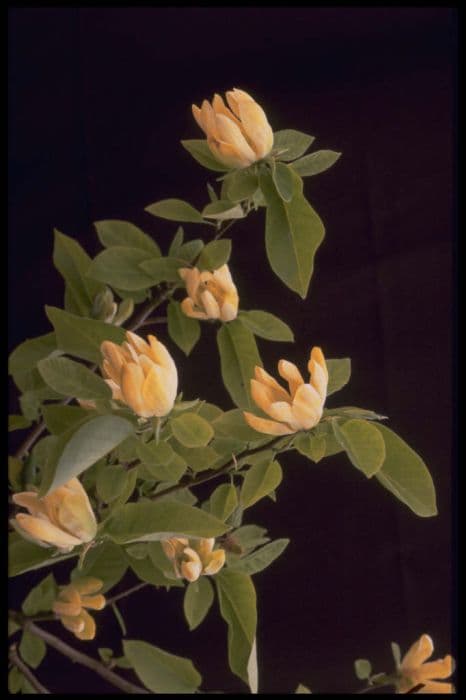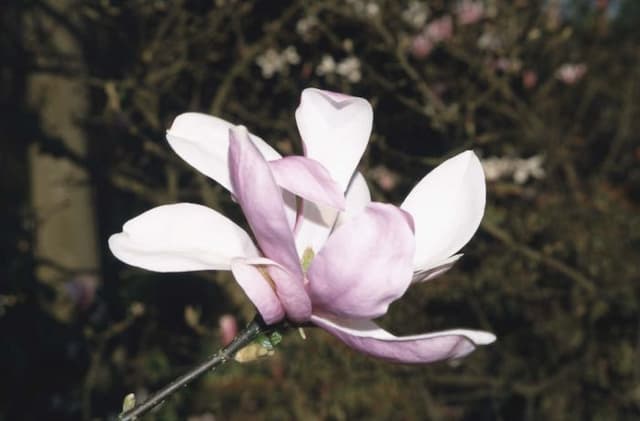Saucer Magnolia Magnolia × soulangeana 'Lennei Alba'

ABOUT
Magnolia × soulangeana 'Lennei Alba', commonly known as the Saucer Magnolia, is a breathtaking plant known for its striking floral display. The flowers are large and showy, with a goblet or saucer-like shape that is a defining feature of this hybrid magnolia. They bloom in early spring, offering a captivating sight even before the leaves fully emerge. The flowers of this variety, 'Lennei Alba', are particularly notable for their creamy white color, which can sometimes have a hint of pink at the base or along the petal edges, giving them a soft, romantic appearance. Each individual flower is composed of thick, waxy petals that fan outwards to reveal a lush, delicate interior. The petals have a smooth texture, and they come together to form a blossom that can be several inches across. As for the foliage, the leaves of the Saucer Magnolia emerge a glossy green color after the flowers start to wither. They are broad and oval-shaped with a pointed tip and provide a lush backdrop for the subsequent floral display. The plant itself has a branching habit that, in the absence of details on size, can be described as spreading, with an attractive, rounded shape that contributes to its overall ornamental value. To sum up, the Saucer Magnolia 'Lennei Alba' is mainly celebrated for its stunning cream to white spring flowers, which are large and pleasantly scented. The glossy green leaves complement the tree’s overall elegance, creating a visually compelling plant that is a highlight in any garden during its blooming season.
About this plant
 Names
NamesFamily
Magnoliaceae
Synonyms
Saucer Magnolia, Tulip Magnolia, Chinese Magnolia, Japanese Magnolia
Common names
Magnolia × soulangeana 'Lennei Alba'.
 Toxicity
ToxicityTo humans
The Saucer Magnolia is not known to be toxic to humans. There are no well-documented cases of poisoning or serious side effects resulting from ingestion of parts of this plant. Therefore, accidental consumption is not expected to cause harm or require medical attention.
To pets
The Saucer Magnolia is not known to be toxic to pets. Similar to its effects on humans, ingestion of parts of this plant is unlikely to cause poisoning or serious health issues in pets like dogs and cats. As a result, the Saucer Magnolia is considered non-toxic, and no significant symptoms of poisoning are anticipated.
 Characteristics
CharacteristicsLife cycle
Perennials
Foliage type
Deciduous
Color of leaves
Green
Flower color
White
Height
20 feet (6 meters)
Spread
15 feet (4.5 meters)
Plant type
Tree
Hardiness zones
5
Native area
Garden origin
Benefits
 General Benefits
General Benefits- Aesthetic Appeal: Magnolia × soulangeana 'Lennei Alba,' commonly known as Saucer Magnolia, has large, showy white flowers that add beauty and elegance to landscapes.
- Spring Interest: Blooms early in the spring, providing a much-needed splash of color after the winter months.
- Shade Production: Its broad, dense canopy offers a cool shade in the heat of the summer.
- Habitat for Wildlife: Attracts a variety of wildlife including birds and pollinators such as bees and butterflies.
- Year-round Interest: Offers structural interest throughout the year with its attractive foliage in summer and fall and distinctive bark and shape in winter.
- Ease of Cultivation: This plant is relatively easy to grow compared to other magnolias, withstanding a variety of soils and climates.
- Drought Resistance: Once established, the tree can withstand periods of drought, making it suitable for various landscapes.
- Low Maintenance: Requires minimal pruning and care once it is established in the landscape.
 Medical Properties
Medical PropertiesThis plant is not used for medical purposes.
 Air-purifying Qualities
Air-purifying QualitiesThis plant is not specifically known for air purifying qualities.
 Other Uses
Other Uses- The wood of the Saucer Magnolia can be used in the construction of small wooden objects like boxes or picture frames due to its fine grain and workability.
- Floral extracts from Saucer Magnolia blossoms are used in perfumery for creating magnolia-scented fragrances, providing a sweet and exotic aroma.
- The bark of the Saucer Magnolia can be used in the process of natural dyeing, offering a range of colors from green to brown depending on the mordant used.
- Petals of the Saucer Magnolia can be candied and used as edible decorations for desserts, bringing a unique flavor and a touch of elegance.
- The large, sturdy leaves can be used in floral arrangements or as a natural wrapping material for small gifts or homemade soaps.
- The blooms of the Saucer Magnolia can be used in the culinary arts, specifically for making floral-infused syrups or vinegars, adding a delicate touch to various recipes.
- The strong branches of this tree can be repurposed into rustic home decor items, such as wall hangings or as support structures for indoor climbing plants.
- Fallen petals and leaves can be utilized as mulch in the garden, providing nutrients to the soil as they decompose.
- The seed pods, when dried, can be used in crafting, for example in wreaths or as natural buttons on homemade clothing or accessories.
- When in bloom, the Saucer Magnolia can serve as an outdoor classroom for botany lessons or nature-inspired art projects, harnessing its educational and aesthetic value.
Interesting Facts
 Feng Shui
Feng ShuiThe Saucer Magnolia is not used in Feng Shui practice.
 Zodiac Sign Compitability
Zodiac Sign CompitabilityThe Saucer Magnolia is not used in astrology practice.
 Plant Symbolism
Plant Symbolism- Perseverance: Magnolia × soulangeana 'Lennei Alba', commonly known as the Saucer Magnolia, often symbolizes endurance and tenacity, as these plants can live for many years and withstand challenging conditions.
- Nobility: With its elegant and dignified blooms, the Saucer Magnolia is frequently associated with nobility and a dignified presence.
- Feminine Beauty: The delicate and striking white flowers of the Saucer Magnolia are seen as a representation of purity, gentleness, and feminine beauty.
- Purity: The pristine white flowers of 'Lennei Alba' are often linked with innocence, cleanliness, and the concept of being unspoiled.
 Water
WaterSaucer Magnolia requires moderate watering, and it is essential to maintain consistent soil moisture without making the soil waterlogged. During the growing season, usually in spring and summer, water once every week with about 1-2 gallons depending on the rainfall and temperatures, ensuring the soil is well-drained but does not dry out completely. In the fall and winter, reduce watering frequency as plant requirements decrease. If you're unsure, check the soil's moisture to a depth of 4 inches; it should feel moist but not soggy.
 Light
LightSaucer Magnolia thrives in full sun to partial shade, but it does best when it receives at least six hours of direct sunlight each day. An ideal spot would be one that offers morning sunlight and some afternoon shade, especially in regions with hot summers, as intense afternoon sun can be harsh on the leaves. Placing the Saucer Magnolia in a well-lit area encourages the most abundant blooms and robust growth.
 Temperature
TemperatureThe Saucer Magnolia is hardy and can withstand temperatures as low as 0°F, although it prefers a temperate climate. The ideal temperature range for this magnolia is between 60°F and 70°F, which promotes healthy growth. It can survive up to around 90°F, but prolonged exposure to temperatures beyond this can stress the plant. Favorable conditions are found in USDA hardiness zones 4 through 9.
 Pruning
PruningPruning the Saucer Magnolia should be done to remove any dead or damaged branches and to maintain the tree's shape. Pruning is best done soon after the tree has finished flowering in late spring or early summer to avoid cutting off next season's blooms. Generally, pruning once a year is sufficient unless you need to address specific issues like broken branches due to weather events.
 Cleaning
CleaningAs needed
 Soil
SoilThe Saucer Magnolia prefers a rich, moist but well-draining soil mix, with a pH of 5.5 to 6.5. A good mix can be prepared with loamy garden soil, compost, and peat moss to enhance drainage and fertility.
 Repotting
RepottingSaucer Magnolias planted in the ground do not require repotting. Container-grown specimens should be repotted every 3-5 years when rootbound.
 Humidity & Misting
Humidity & MistingSaucer Magnolia thrives in outdoor humidity levels, generally not requiring specific humidity adjustments when planted in the garden.
 Suitable locations
Suitable locationsIndoor
Not suitable for indoor growing due to size and light needs.
Outdoor
Plant in well-draining soil, full sun to part shade.
Hardiness zone
4-9 USDA
 Life cycle
Life cycleThe Saucer Magnolia 'Lennei Alba' begins its life cycle as a dormant seed which, after stratification during the winter, germinates in the spring. The seedling emerges and establishes its root system while developing its first leaves and stem. As it enters the vegetative stage, it grows leaves and branches, forming a robust shrub that progressively grows into a small tree. Once the tree reaches maturity, usually after several years, it starts producing large, fragrant, white flowers, typically blooming in early spring before the leaves fully expand. After pollination by insects, it sets fruit, which is a cone-like aggregate of follicles containing the seeds and matures in late summer to early fall. The plant's life cycle continues as these seeds are dispersed, often by wind or wildlife, completing the cycle when they find suitable conditions to germinate and start a new generation.
 Propogation
PropogationPropogation time
Spring
The most popular method of propagating Magnolia × soulangeana 'Lennei Alba', commonly known as Saucer Magnolia, is through the collection and planting of seeds in the fall immediately after they ripen. Seeds should be cleaned and stratified for several months at 40°F (approximately 4°C) to overcome dormancy. After stratification, seeds are sown in a well-draining growing medium and should ideally be placed in a cold frame or greenhouse where they can be protected from extreme temperatures during germination. Although this method requires patience as it may take several years for seedlings to flower, it allows the production of new plants that retain many of the parent plant’s characteristics.


![Magnolia [Fairy Blush]](/_next/image?url=https%3A%2F%2Fplants-admin.emdemapps.com%2Fimages%2Fplants%2F%2Fimages%2F604b5a108e959.png&w=640&q=75)






![Magnolia [Black Tulip]](/_next/image?url=https%3A%2F%2Fplants-admin.emdemapps.com%2Fimages%2Fplants%2F%2Fimages%2F604b590290fc7.png&w=640&q=75)